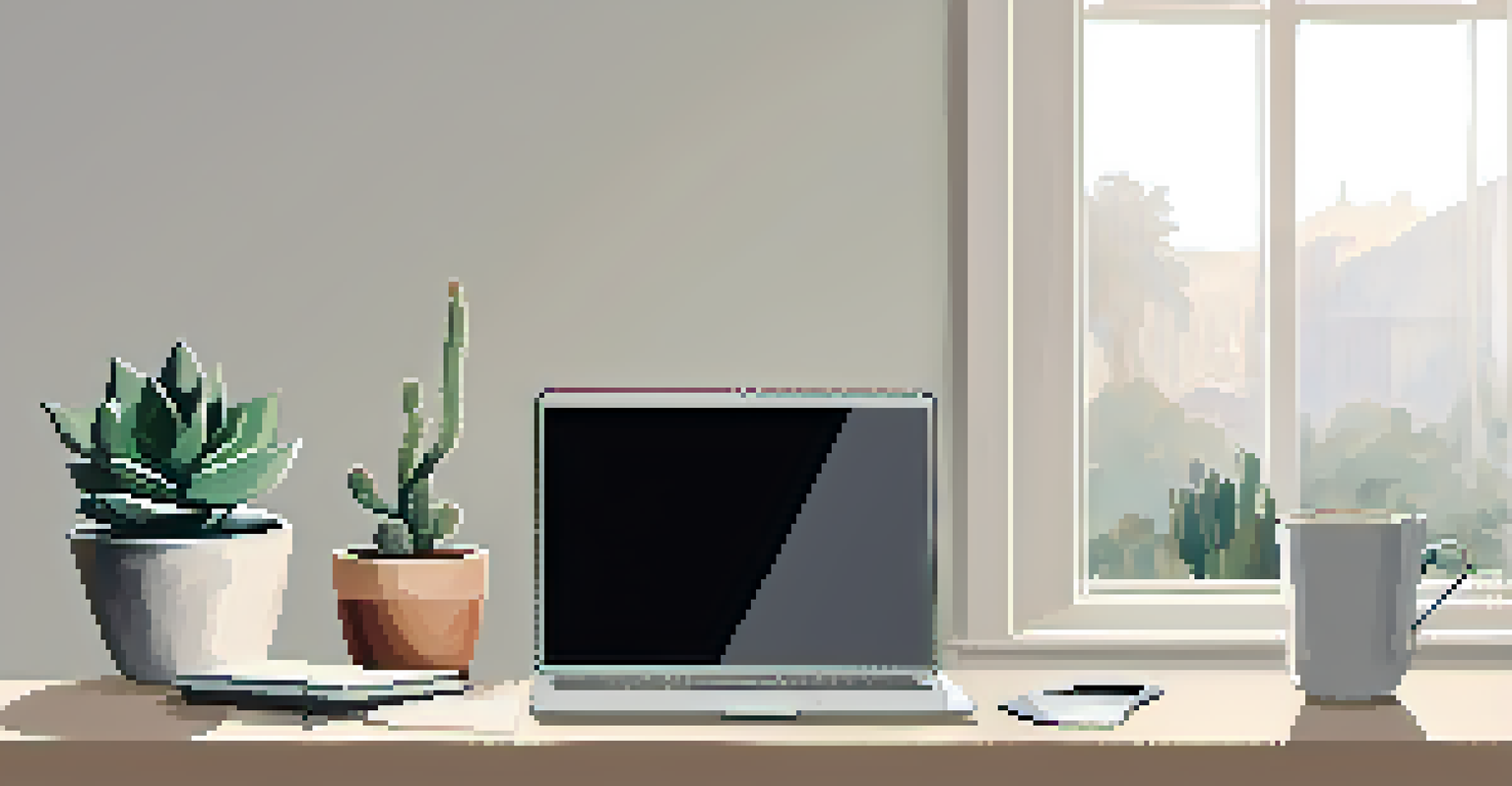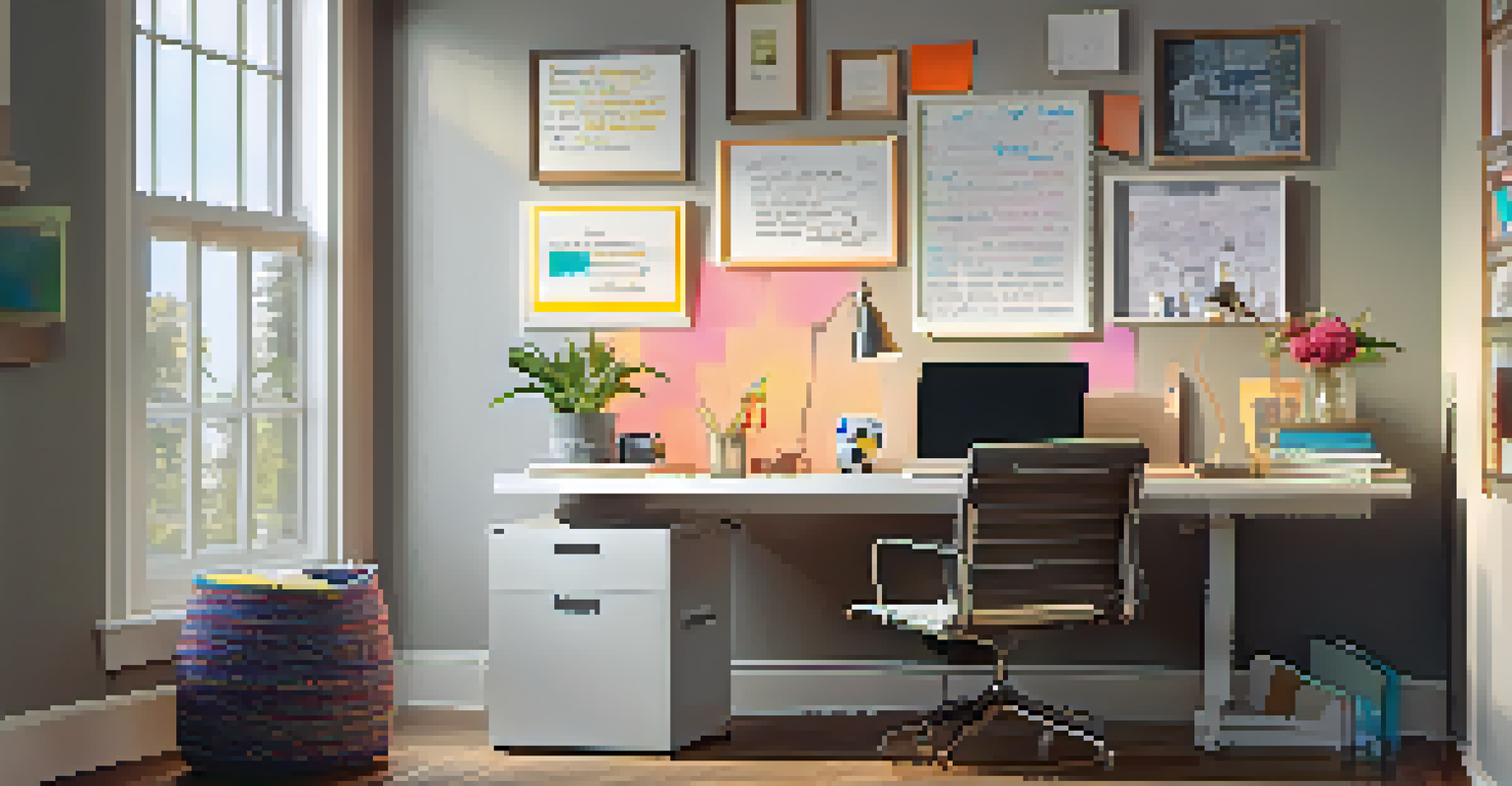Creating an Inspiring Workspace for Better Balance

Understanding the Importance of Workspace Design
A well-designed workspace can significantly impact your productivity and mental well-being. When you create an environment that inspires you, it encourages creativity and focus. Think of your workspace as a canvas; every element you add contributes to the bigger picture of your work-life balance.
The environment you create around you can either inspire you or drain you.
Research has shown that our surroundings directly influence our mood and efficiency. For instance, a cluttered desk can lead to distraction, while a tidy, organized space allows for clear thinking. This is why understanding the importance of workspace design is the first step in fostering a productive atmosphere.
Ultimately, a positive workspace can lead to improved morale and job satisfaction. It’s essential to create a space that reflects your values and supports your work style, ensuring that you feel at ease while you accomplish your tasks.
Choosing the Right Location for Your Workspace
The location of your workspace plays a crucial role in how effectively you can work. Ideally, you want a space that's away from distractions, yet comfortable enough to promote creativity. For example, if you work from home, consider setting up in a quiet room where you can close the door and focus.

Natural light is another important factor to consider. Studies suggest that exposure to natural light can enhance mood and energy levels, making it easier to stay productive. If possible, position your desk near a window, so you can enjoy the benefits of daylight while you work.
Workspace Design Boosts Productivity
A well-designed workspace enhances creativity, focus, and overall job satisfaction.
Additionally, think about the noise levels in your chosen location. Some people thrive in a bustling environment, while others need absolute silence to concentrate. Understanding your preferences will help you select the best spot for your workspace.
Incorporating Ergonomics for Comfort and Health
Ergonomics is the science of designing your workspace to fit your needs, promoting comfort and efficiency. Investing in ergonomic furniture, such as a chair that supports your back and a desk at the right height, can prevent physical strain and discomfort. This is especially important if you spend long hours at your desk.
Design is not just what it looks like and feels like. Design is how it works.
For instance, adjustable desks allow you to alternate between sitting and standing, which can help reduce fatigue and improve circulation. Small changes, like using a footrest or positioning your computer screen at eye level, can also make a big difference in how you feel throughout the day.
Ultimately, prioritizing ergonomics not only enhances your comfort but also boosts your productivity. A workspace that supports your physical health allows you to focus on what truly matters: your work.
Adding Personal Touches for Inspiration
Personalizing your workspace can significantly enhance your motivation and creativity. Incorporating items that inspire you, such as artwork, plants, or photos of loved ones, can create a welcoming atmosphere. Think of these personal touches as little reminders of your goals and the things that bring you joy.
For example, a small indoor plant can not only beautify your desk but also improve air quality and reduce stress. Additionally, displaying quotes or affirmations that resonate with you can serve as a source of encouragement during tough workdays.
Ergonomics Enhance Comfort and Health
Investing in ergonomic furniture helps prevent physical strain, allowing for better focus during work.
Remember, your workspace should reflect who you are and what you stand for. By adding personal elements, you create an environment that feels uniquely yours and fosters a sense of belonging.
Creating Zones for Different Activities
One effective way to enhance your workspace is by creating distinct zones for different activities. This segmentation can help you switch between tasks more efficiently and maintain focus. For example, designate one area for deep work, another for meetings, and a cozy corner for brainstorming.
By having specific zones, you can signal to your brain what type of work you need to do based on where you are seated. This can reduce the mental clutter that comes from trying to multitask in the same space. It’s like having different rooms in your house for various activities, making it easier to shift gears as needed.
Additionally, consider incorporating elements that support each zone’s purpose. A comfortable chair for reading, a whiteboard for brainstorming, or a quiet nook for focused work can enhance your overall productivity and work-life balance.
Embracing Minimalism for Clarity and Focus
Minimalism in your workspace can lead to greater clarity and focus. A clutter-free environment reduces distractions and allows you to concentrate on your tasks. Think of it this way: when your workspace is neat and organized, your mind can be as well, paving the way for better creativity and productivity.
To embrace minimalism, start by decluttering your desk. Keep only the essentials and remove anything that doesn’t serve a purpose. This doesn’t mean you can’t have personal touches; rather, it encourages you to carefully select what you truly value and need.
Personal Touches Inspire Motivation
Incorporating personal elements into your workspace fosters a welcoming atmosphere and boosts creativity.
Ultimately, a minimalist workspace can foster a sense of peace and calmness, allowing you to approach your work with a clearer mindset. It’s all about finding that balance between functionality and aesthetics.
Incorporating Technology to Enhance Productivity
In today’s digital age, technology plays a significant role in our workspaces. Utilizing the right tools and applications can enhance your productivity and streamline your workflow. Consider software that helps with task management or digital calendars to keep your schedule organized.
Additionally, investing in high-quality tech equipment, such as a reliable computer, monitor, or noise-canceling headphones, can make a world of difference. These tools not only improve efficiency but also create a more enjoyable working experience.

However, it's essential to find a balance. While technology can aid your productivity, be mindful of how much time you spend on screens. Integrating tech wisely into your inspiring workspace can help you maintain that crucial work-life balance.